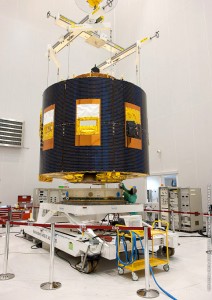
At the end of last week, the latest weather satellite in Europe’s successful Meteosat second-generation project was launched with an Ariane 5 rocket. The launch was made from Europe’s Spaceport at the Guiana Space Centre in Kourou, French Guiana, at 21:36 GMT (23:36 CEST) on Thursday, 5 July.
The satellite is currently being controlled from ESA’s European Space Operations Centre, in Darmstadt, Germany, and on the 15 July, ten days after launch, the MSG-3 will be handed over to the satellite’s owner, the European Organisation for the Exploitation of Meteorological Satellites, EUMETSAT, to commission the payload, once all initial operations are completed.
Meteosat Second Generation is a joint programme undertaken by ESA and EUMETSAT where ESA is responsible for the development of satellites and in turn fulfilling user and system requirements that are defined by EUMETSAT. The European Space Agency also performs the Launch and Early Orbit Phase operations required to place the spacecraft in geostationary orbit. It then hands over control to EUMETSAT for exploitation.
EUMETSAT develops all ground systems required to deliver products and services to users and to respond to their evolving needs. It also procures launch services and operates the full system for the benefit of users.
MSG-3 is the third in a series of four satellites introduced in 2002. The satellites are spin-stabilised and carry the primary Spinning Enhanced Visible and Infrared Imager, or SEVIRI that scans Earth’s surface and atmosphere every 15 minutes in 12 different wavelengths, to track cloud development and measure temperatures. SEVIRI focuses on Europe and Africa to deliver enhanced weather coverage, in order to improve local forecasts, in particular for rapidly developing storms. SEVIRI can pick out features as small as a kilometre across in the visible bands, and three kilometres in the infrared.
In addition to its weather-watching mission and collection of climate records, MSG-3 has two secondary payloads. One is the Global Earth Radiation Budget sensor that will measure the amount of solar energy that is radiated back into space. The purpose is to determine the amount of energy is introduced into the climate system and to provide insights into the atmospheric circulation between the day and night sides. The second payload is a Search & Rescue transponder that will turn the satellite into a relay for distress signals from emergency beacons.
The MSG satellites were built in Cannes, France, by a European industrial team led by Thales Alenia Space, France. More than 50 subcontractors from 13 European countries are involved. The last of the series, MSG-4, is planned for launch in 2015.
